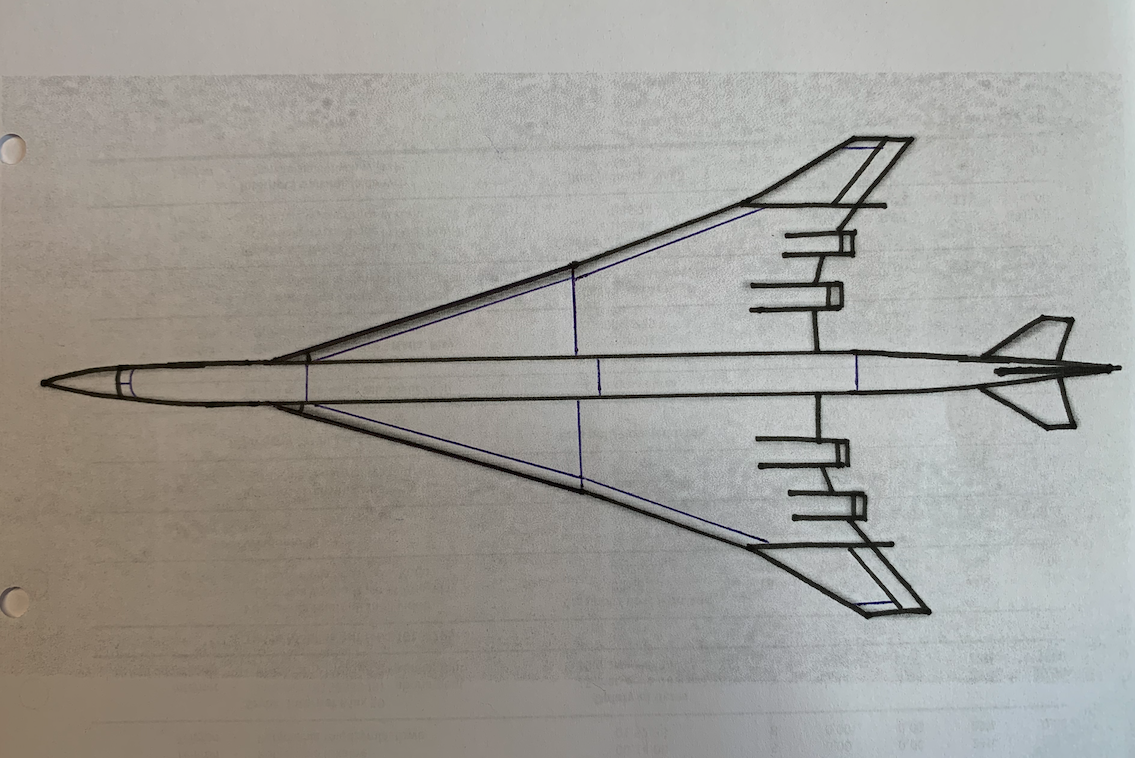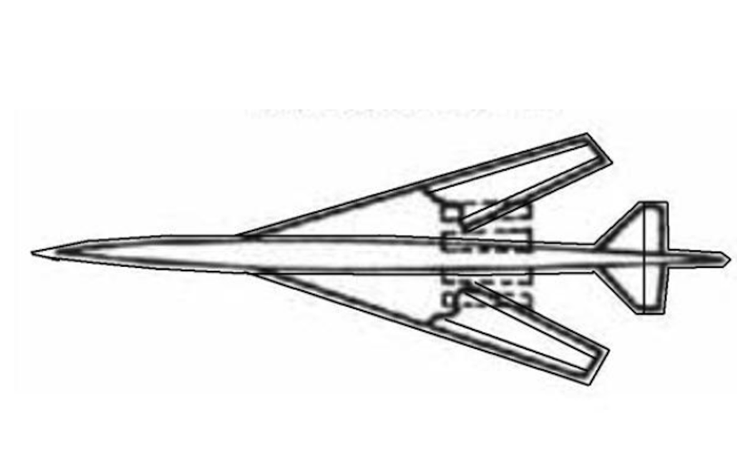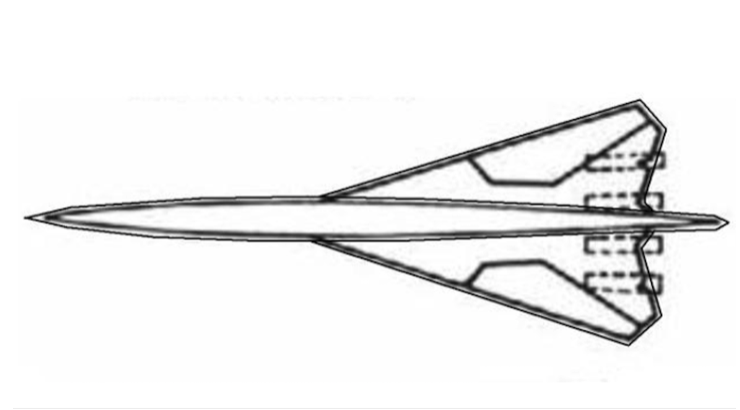Kraków 2015-09-23
US supersonic passenger aircraft. 1970-1980
US supersonic aircraft programs.
NASA/Ling Temco Vought.
Project Supersonic NASA Ling Temco Vought is a theoretical and research program on supersonic communication aircraft that was conducted in the 50s/60s of the 20th century. It did not end with the construction of a specific prototype, but pointed out the difficulties that stand in the way of such a concept and the ways to solve them. Initially, the work was carried out by NACA/NASA, which at some point invited the Vought aviation company, which was mainly known for its F-8 supersonic combat aircraft, to cooperate. On this plane, among others, wings with a supercritical profile were tested.
Photo Description: One of NASA’s possible LTV projects. Take-off weight 330,000 kg. Number of seats 292 passengers. Cruising speed 2.6 Ma. Range 7,350 km.
Boeing.
Work on a commercial supersonic aircraft (SST) at Boeing has been carried out at its own risk since 1952. In 1958, a commission was appointed to carry out further work. The program was designated Model 733. Within its framework, several projects were created. Most of them had a delta-wing layout, although there were designs with variable wing geometry. Initially, the hull capacity for 150 passengers was opted for.
After President John F. Kennedy took office, the Federal Aviation Administration (FAA) was commissioned to prepare a report on the state of civil aviation. As a result of the audit, two programs were born, among others; Project Beacon for new navigation and air traffic control systems and Project Horizon for advanced changes in civil aviation. Among other proposals, the report was used as a platform to promote the SST programme. In addition, the administration of President John F. Kennedy committed to finance 75% of the cost of the program. All this to win the competition with Western Europe. The ambitions of the Americans were greater than the level of the Concord aircraft. The aircraft was to carry 250 passengers, fly at Mach 2.7-3.0 and have a range of 4,000 NM (7,400 km). The program officially started on June 5, 1963.
A great discussion ensued. The basic idea behind the SST was that its high-speed flight would allow it to carry more people. Although at the expense of increased fuel consumption. Fuel costs have become extremely significant. If fuel is too expensive, SST will not be competitive. These problems were well understood in industry; The IATA (International Air Transport Association) issued a set of "design imperatives" for the SST that were basically impossible to meet. This situation cooled the SST promoters even before the concept issue was solved; delta wings or variable geometry. As we remember, the military chose the North American XB-70 aircraft in the first configuration, and the General Dynamics F-111 in the second configuration.
Nevertheless, requests for proposals were sent to aircraft manufacturers; Boeing, Lockheed, North American and engine manufacturers; Curtiss-Wright, General Electric and Pratt & Whitney. Not only that, the first orders began to flow in from the airlines. On January 15, 1964, the FAA opened the design envelopes.
Boeing presented the already familiar design from 1960, but revised Model 733 -197 (Model 1966 and Model 2707). Capacity from 150 to 227 passengers.
Lockheed.
The Lockheed CL-823 design was essentially an enlarged Concorde. Four engines placed in individual nacelles, not in pairs. The wings had no lift-enhancing devices. Therefore, the aircraft required longer runways (RWYs) and emitted more noise. It was scheduled to carry 218 passengers.
North American.
The North American NAC-60 was a design based on the XB-70 bomber. Thanks to the more blunt bow, it did not require the use of the hull forward rake. He also received a new wing; oblique, with flaps on the leading edge. Drive four engines grouped in pairs, under the wings. Compared to other designs, the rounded nose profile and more cylindrical cross-section gave the NAC-60 a decidedly more conventional appearance. But its cruising speed was the slowest; 2.65 Ma.
Further work.
Boeing and Lockheed have moved on to the next stage of SST work. Curtiss-Wright withdrew from the engine program, and further work was continued by GE and P & W. In November 1964, a design review was held.Boeing enlarged its plane, which could now take 250 passengers on board. The aircraft was designated Model 733-290. In it, the engines were moved backwards, which were then placed under the part of the wing that we can call the horizontal tail. Now the wing had a delta outline with the folded wings, and a polygon (polygon) with the unfolded wings.
The Lockheed L-2000 aircraft was based on a less risky design and was supposed to be simpler to manufacture.Both companies had until 1966 to submit more detailed designs. In September 1966, both companies unveiled full-size mock-ups; Boeing Model 733-390 (up to 300 passengers), Lockheed L-2000. On January 1, 1967, the Boeing Model 733-390 project was declared victorious and the General Electric GE4/J5 engines were selected.
The Boeing Model 733-390 was an extremely advanced and modernist design. Not only was it the first American supersonic aircraft, but also the first wide-body aircraft with a 2-3-2 seating arrangement (with two aisles). The 247-seat Tourist Class main cabin features an entertainment system consisting of retractable TVs located between each sixth row of suspended luggage compartment. There were 30 seats in the first class. For each pair of seats, there is one smaller TV set in the panel between the seats. The windows were only 6 inches diagonal (as in a smartphone), but the internal panes of the windows were as much as 12 inches to give the impression of size.
Boeing envisioned that if the SST program went ahead, a prototype would be built by the end of 1969, a flight would take place in early 1970, and certification in 1974.
But it wasn’t that good. The axis of the fuselage ran in an arc and it was not very clear how the aircraft would behave in flight at high speeds. The design had problems with maintaining weight due to the use of variable geometry and a lowering bow. In October 1968, the company was finally forced to abandon the variable geometry wing. The revised design was also smaller, carrying 234 passengers. The design was designated Model 2707-300 (September 1969). A mock-up was built again and the construction of two prototypes began. Additionally, Boeing claimed that the Boeing 747 program was only a transitional project and SSTs would soon be in the sky.
In addition, environmentalists protested louder and louder. They had great influence. They claimed that these planes would destroy the ozone layer. Around the airports, noise will exceed 115 dB. Supersonic thunder is harmful. And finally, passengers will be exposed to cosmic rays. Environmentalists printed pamphlets and produced anti-SST films. In fact, during the XB-70 test in 1965 near Oklahoma City, the track of the sonic boom had a maximum width of 16 miles and generated 9,594 complaints of damaged buildings, 4,629 formal claims for damages, and 229 lawsuits totaling $12,845.32. (mainly for broken glass and cracked plaster). There were also other accusations. For example, that the water vapor from the engines will envelop the Earth in one big cloud and there will be darkness, "global gloom". A fleet of 500 SST aircraft flying at 65,000 ft for a year can raise stratospheric humidity from 50% to 100%, which will adversely affect the ozone layer. The scientists themselves argued among themselves, and their study of the atmosphere, after the possible introduction of the SST, continues to the present (2013). None of these studies have confirmed or denied the catastrophe associated with the use of supersonic commercial machines.
There was another problem in the US. The SST program was 75% funded by the government administration, with profits to be made by private companies. Therefore, it was relatively easy to launch a campaign against unnecessary spending by the federal government. As a result, in March 1971, the administration of President Richard Nixon stopped funding the SST program. But the public reacted very spontaneously. A "National Committee for an American SST" was organized, which was supported by trade unions. Private donations started pouring in. It should be remembered that at that time unemployment in the US aviation sector was increasing (the end of the Apollo program and the end of the Vietnam War). Many politicians realized that the race to the first generation of SST aircraft was lost by the Americans. But in the competition for the second generation of the SST for the 1980s, anything was possible. These politicians said that relaunching the program in a new form would create 13,000 jobs and another 50,000 in subcontractors, and 150,000 jobs a year over the next ten years.
The two Model 2707-300 prototypes were never completed. The global oil crisis has arrived. An order for 122-115 machines, from 26-25 airlines, quickly dwindled to zero. Similarly, orders for Concorde had 74 orders from 16 carriers. Boeing laid off 60,000 employees in a short time. It is claimed that the SST program nearly bankrupted the company. A billboard, so well known to Poles, appeared in Seattle – "Will the last person leaving Seattle – turn out the lights." (The last person to leave Seattle will turn off the light.)
Four General Electric GE4/J5P engines were envisaged as the drive. These were engines based on the General Electric YJ93 design that powered the North American XB-70 bomber. The GE4s had 4 x 50,000 lbf (4 x 220 kN) thrust without afterburning and 4 x 65,000 lbf (4 x 290 kN) with afterburning. The engine had a variable blade angle. It had less thrust at sea level, but had high efficiency at high altitudes. The engine booster was to have a minimum of two levels of operation. At cruise ceiling, the engine boosters had to run on the first stage. The program was implemented in the period 1967 – 1971. In 1970, the prototype already had over 600 hours of testing on the dynamometer. During the tests, the engine achieved the assumed thrust of 28,670 kG (286.70 kN).
Data T-T Boeing 2707-200:
Length 306 ft (93.27 m), width 180 feet 4 inches (54.97 m) spread 105 feet 9 inches (32.23 m), height 46 ft 3 in (14.10 m), curb weight 287,500 pounds (130,400 kg), max weight 675,000 pounds (306,000 kg), lifting capacity 75,000 lb (34,000 kg), the aircraft could take up to 277 passengers on board. Max speed Mach 2.7: 1,800 miles / hour (2,900 km/h). Range of 4,250 miles (7,871 km) with 277 passengers. Inrun 5,700 ft (1,700 m), landing 6,500 feet (2,000 m).
Lockheed.
The Lockheed L-2000 was the main competitor of the Boeing 2707 aircraft for the SST program. Lockheed began work on a supersonic passenger plane in 1958. The designers aimed very high; an aircraft with a cruising speed of 2,000 mph (3,219 km/h). The engineers knew about the variable wing geometry layout. But the weight of such a system was questionable. Engineers were ready to go back to the classical system, with fuel pumping to equalize the center of pressure with the center of gravity. The problem, however, is that the shift was significant. Attempts were made to remedy this by changing (many times) the outline of the lobes.The new design was designated L-2000-1. The aircraft was 223 feet (70 m) long. The fuselage was narrow; 132 inches (3.352 m). However, its width is ensured by the 3 x 2 seat layout in economy class and 2 x 2 in first class. The aircraft in a two-class layout will accommodate 170 passengers, and in a single-class layout 200 passengers. The leading edge of the wing is 80 degrees at the fuselage and 60 degrees out. The airfoil area is 8,370 ft² (778 m²). The relative thickness of the profile is 3%. Such an aerodynamic arrangement will allow the aircraft to take off at the same speed as the Boeing 707 aircraft. Three-support landing gear. Front with two wheels. The main ones are 6-wheel carts. Same tires as the Douglas DC-8 aircraft, but filled with nitrogen and lower pressure.
The propulsion was provided by the technically advanced Pratt & Whitney J58 engines that powered the Lockheed A-12 and SR-71 Blackbird. It was hoped that this plane would take off without the use of afterburners, i.e. relatively quietly. (However, there were concerns whether it would be possible on hot days and at high-altitude airports?). The speed of sound will be exceeded at over 30,000 ft (9,144 m). The aircraft is to reach full speed at 71,500 ft (21,793 m), and the cruising ceiling will be 76,500 ft (23,317 m). Everything will be done automatically and precisely to minimize possible supersonic thunder. Landing step, also had to be precise.
In 1964, the US administration clarified the requirements for the SST and as a result Lockheed had to modify the design. This is how the Lockheed L-2000-2 was created. Wing modified (relative thickness decreased to 2.3%, leading edge angles increased to 85 and 62 degrees, aerodynamic buckling increased, area 9,026 ft ² (838.5 m²), span unchanged). The overall lift-to-drag ratio increased from 7.25 to 7.94. The aircraft received a new, shorter nose, which shortened the length of the aircraft to 214 feet (65.2 m).
There was such a problem with the Pratt & Whitney J58 engine that it was a highly advanced design and was created for the needs of the army. Nevertheless, Lockheed obtained approval for the use of these engines in civilian construction, although they were substantially rebuilt in several elements. Pratt & Whitney designed a new afterburner and a new fan, designated JTF-17A. Such an engine provided more power. The afterburner was to have at least two operating ranges. The high-altitude engine must have had the afterburner on in the first stage. It was not entirely clear what fuel the engine would run on. Had it been the fuel used for the Lockheed SR-71, not only would it have been very expensive, it could also have been difficult to distribute.
The integration of the powerplant with the airframe in both designs was so great that the indication of the winning aircraft company immediately pointed to the winner in the development and production of engines. It was not possible to offer a choice of engines for users.
Lockheed L-2000 in the largest version was to take 250 passengers on board. For transatlantic flights, room for 220 passengers was envisaged. Lockheed envisaged the construction of aircraft in various fuselage lengths. He also took into account the layout of the variable geometry of the wings.
By 1966, the designs had reached their final form and were the L-2000-7A and L-2000-7B. The L-2000-7A project received a re-lengthened fuselage of 273 ft (83 m), it took 230 passengers on board. The wing was enlarged and moved forward. It received greater geometric and aerodynamic buckling. The leading edge is 84 and 65 degrees. Area 9,424 sq ft (875 m2). Takeoff weight 590,000 pounds (267,600 kg). Flaps appeared on the leading edge. At the end of the fuselage, a lower aerodynamic steering wheel was mounted. The L-2000-7B design was longer; 293 ft (89 m). Its tail was raised higher to maintain a high angle of attack during takeoff and landing. Take-off weight same as version A; 590,000 pounds (267,600 kg). The first flight of the prototype was planned in 1971.
Data T-T Lockheed L-2000-7:
273 passengers. Length 273 ft 2 in (83.26 m), span 116 ft (35.36 m), wing area 9,424 ft² (875 m²), curb weight 238,000 lb (107,900 kg), max weight 590,000 lb (267,600 kg), range 4,000 NM ( 7,400 km), cruise ceiling 76,500 ft (23,317 m). Pratt & Whitney JTF17A-21L engine.
End of SST program.
The mock-ups of the Boeing 2707-200 and L-2000-7 were presented to the FAA and on December 31, 1966. The winner was declared a Boeing design, which at that time had a variable geometry wing system. The Lockheed L-2000-7 design was judged to be less risky, but the Boeing design offered a greater advantage over the Concorde.
Government funding ceased on March 24, 1971, and the SST program was canceled on May 20, 1971.
Written by Karol Placha Hetman



